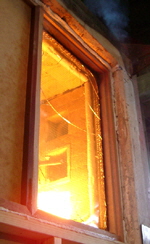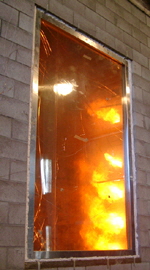|
Recommendations & Conclusions
‘Glass Breaking in Fires’ provides a sound theoretical basis for observed window behaviour in fires. It has found application in a number of fire models including BREAK1 and BRANZfire to predict time to window breakage and is well cited in subsequent literature.
 While the calculation method is well-founded, the authors recognised the need for good compartment fire temperature histories, good estimates for convective and radiative heat transfer parameters and, most importantly, a good estimation of glass tensile strength at the time of breakage. While still not perfect substantial improvements have been made in the modeling of simple compartment fire histories and the determination of heat transfer parameters. But predicting glass tensile strength remains problematic. It is recommended that a conservative value of 40 MPa is adopted for practical application. While the calculation method is well-founded, the authors recognised the need for good compartment fire temperature histories, good estimates for convective and radiative heat transfer parameters and, most importantly, a good estimation of glass tensile strength at the time of breakage. While still not perfect substantial improvements have been made in the modeling of simple compartment fire histories and the determination of heat transfer parameters. But predicting glass tensile strength remains problematic. It is recommended that a conservative value of 40 MPa is adopted for practical application.
Of course cracking does not always result in window failure and the glass fallout problem has yet to be addressed.
For many fire problems a first approximation to window failure is when gas temperatures in the compartment reach approximately 300°C. Given that many design fires are based on exponential fire growth and the difficulty of accurately predicting glass properties this approach is likely to be sufficiently accurate for many purposes providing conservatism is exercised.
Where specific glazing integrity or insulation is required specialised glazing or active protection may be required. There are numerous systems available that offer enhanced fire performance compared with standard window glazing.
Wired glass, often referred to as Georgian wired glass, cracks at the same time as ordinary window glass but the wire holds the glass fragments in place overcoming the fallout problem (image at left).
Tempered glazing provides increased time to breakage due to the compressive stresses present in the glass which are introduced by rapid cooling during manufacture.
The paper suggests that glasses with low thermal expansion may be a solution to glass breaking in fires. Ceramic glass has a very low thermal expansion coefficient so tensile stress is not developed in the edges shielded by the frame. Ceramic glass has found application in glazing and other hot applications such as ceramic stove tops.
For practical fire design of glazing systems radiant heat transmission through the glazing remains an important consideration.
Where radiation is a significant issue reactive glazing systems such as Pyrobel (image at right) can be specified. These systems are often made of composites comprising layers of glass separated by compounds such as sodium silicate that become opaque on heating.
References and Further Reading
Babrauskas, V., ‘Glass Breakage in Fires’, Fire Science and Technology Inc., 2009
Bennets, I. D., Thomas, I. R., Lewins, R. R., ‘Capita Facade Fire Tests’, BHP Research, 1988
Beatson, D., ‘Fire Endurance of Sprinklered Glass Walls’, Fire Journal, 1986
DeHaan, J. D., ‘Kirk’s Fire Investigation’, 4th Ed. Brady Prentice Hall, 1997
Emmons, H.W., ‘The Needed Fire Science’, Fire Safety Science Proc. First Intl. Symp., 1986
Kang, K., “Assessment of a Model Development for Window Glass Breakage due to Fire Exposure in a Field Model’, Fire Safety J., 2009, 44, iss.3, pp 415-424
Keski-Rahkonen, O., ‘Breaking of Window Glass Close to Fire’, Fire and Materials 12, 61-69 (1988)
Kim, A. K., ‘Fire Exposure of Glazing’, Proc. of the Fourth Conference on Building Science and Technology’, National Research Council Canada, 1988
Pagni, P. J., Joshi, A. A., ‘Glass Breaking in Fires’, Fire Safety Science Proc.Third Intl. Symp., pp. 791-802
Parry, R., ‘Implementation of a Glass fracture Model for the BRANZfire Compartment Fire Zone Modelling Software Program’, J. of Fire Prot. Engr., 2003, 13, pp 157-183
Pope, N. D., Bailey, C. G., ‘Development of a Gaussian Glass Breakage Model within a Fire Field Model’, Fire Safety J., 2007, 42, iss. 5, pp 366-376
Richardson, J. K., Chown G. A., ‘Glazing in Fire Resistant Wall Assemblies’, National Research Council Canada, 1988
Skelly, M. J., Roby, R. J., et al., ‘An Experimental Investigation of Glass Breakage in Compartment Fires’, J. of Fire Prot. Engr., 1991, pp 25 -34
|